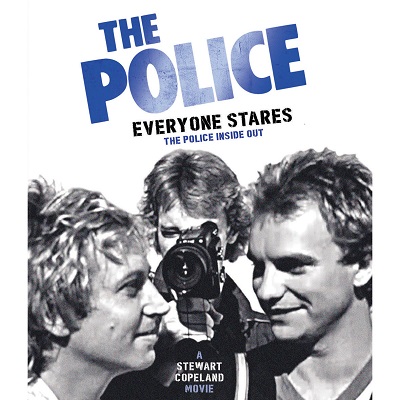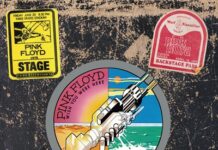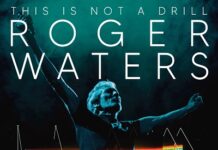Thirteen years after making a splash at the Sundance film festival, Stewart Copeland’s Everyone Stares, the drummer’s cinematic first-person point of view of the Police’s rise to stardom, has been reissued on Blu-ray Disc and digital video for the first time. I came to several conclusions after watching the 74-minute film. Back in the heady days of the Police, Andy Summers was a funny guy, Sting was extremely high strung, Copeland himself was a unique and relentless cameraman, the group as a whole was a kooky cog in the punk rock wheel rolling to nowhere, and the legions of fans pretty much went gaga over these guys. Copeland’s account was spontaneously shot with a Super 8 mm movie camera over the course of cheap motels, chain hotels, press conferences, in-stores, radio shows, photo and video shoots, recording sessions, concerts, and a spot of paradise. Drawing from over 50 hours of footage, the frenetic pace of the film accurately parallels the band’s ascension to the top.
It’s no secret the Police were a beacon of hope in the mucky spew of punk rock. They climbed aboard the new wave bandwagon, but possessed a higher sense of musicality that separated them from the pack. Copeland chronicles each and every phase — from the Police’s humble beginnings, their shifty origins, numerous club gigs, the hustle and bustle and march to the hit parade. It didn’t take long for the blonde trio to catch on, especially with the girls. That was only a small part of it. When they played, The interaction between Sting, Summers and Copeland, often vitriol on the surface, created a distinctive, rip-roaring mixture of jazz, reggae, prog and punk. It was fast, aggressive, ethereal and majestic in all the right places.
The handheld camera work is well placed within the montages as Copeland steadfastly narrates the story. Most of the actual live performances are incomplete, but Copeland has creative license as a member of the band. In one instance he places the camera on a tripod behind him during a concert as he pounds out a simple rhythm and alternately turns to yap at the camera. In the very next clip, he takes off in a flurry of paradiddles, splishes, splashes, and heavy thudding. An omniscient bit of film occasionally captures the entire band (the camera is pointed at Sting and Summers for most of the film), such as the high-energy moments from “Next To You,” gauging their range as live performers. Another classic moment has Copeland filming himself, Summers, and Sting rolling around in the snow during the making of the video for “De Do Do Do, De Da Da Da.”
The fun and games don’t last forever as Copeland expresses his disillusionment with the road and the other band members. The Police scale the precipice of supremacy with 1981’s Ghost In The Machine, Sting and Summers scowl at the camera, and the film abruptly ends. There is no mention of Synchronicity, arguably the biggest and best Police album, or the subsequent break-up. And this may well sum it up through Copeland’s eyes. Perhaps when the Police finally came into their own, the pressure and expectations sapped and drained the band of its creative ambitions. Since then, all three members have carried on in various creative capacities, mostly musical. Andy Summers even made a film of his own about the Police called Can’t Stand Losing You. Sting has had incredible success as a solo artist, but even he can’t deny the power of the Police, so nicely and personally captured in Everyone Stares.
~ Shawn Perry




















